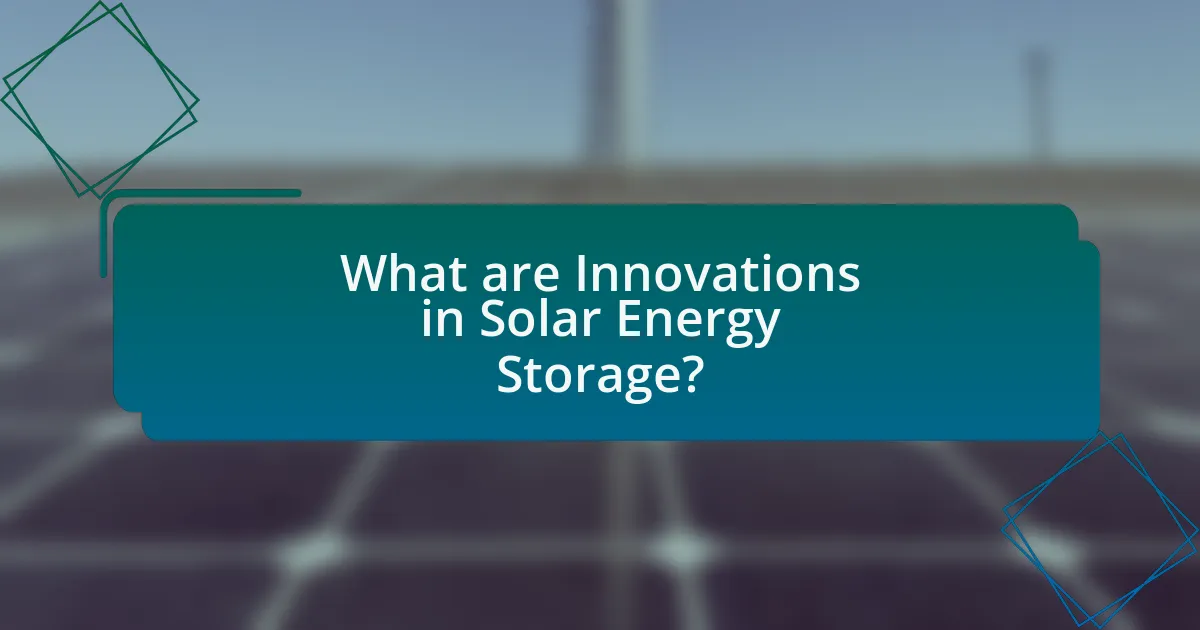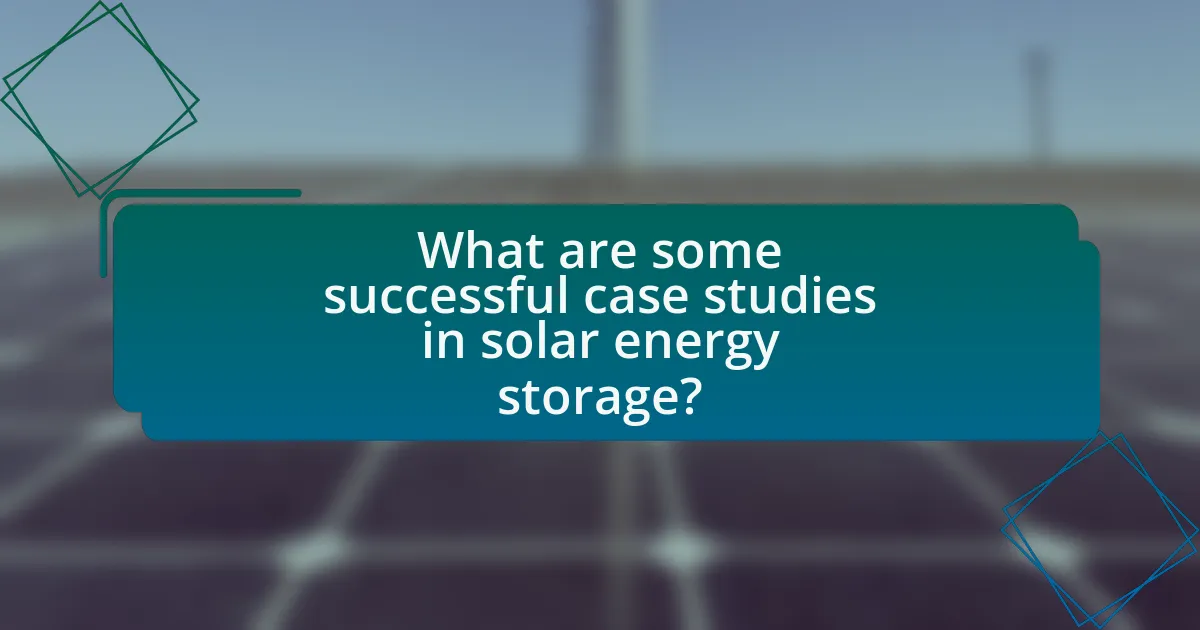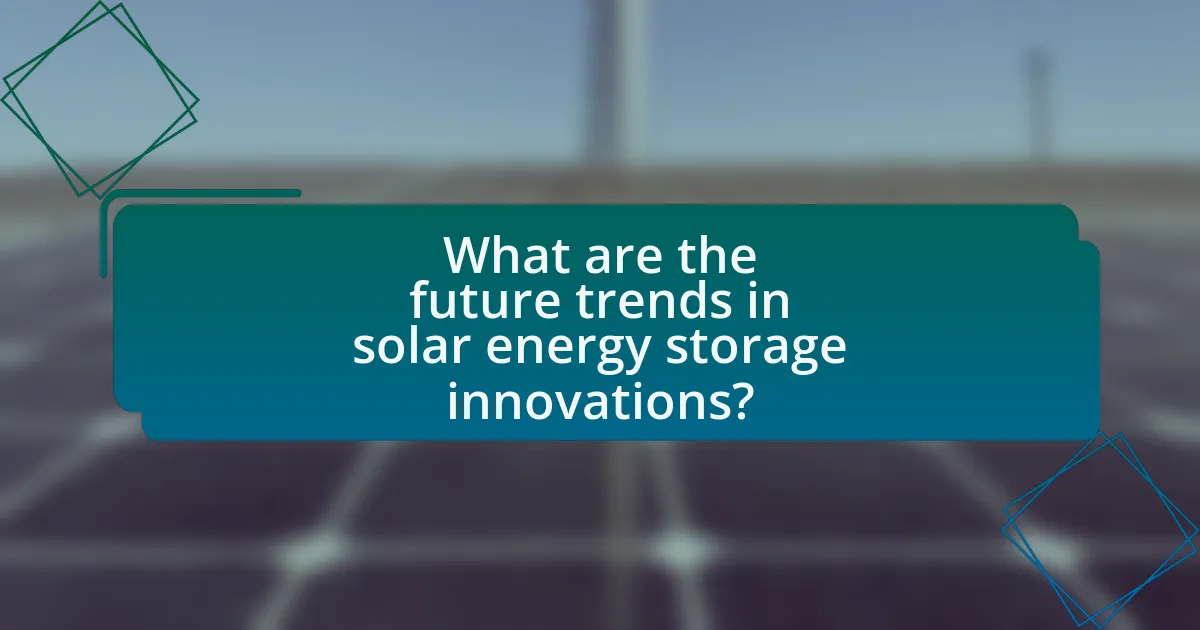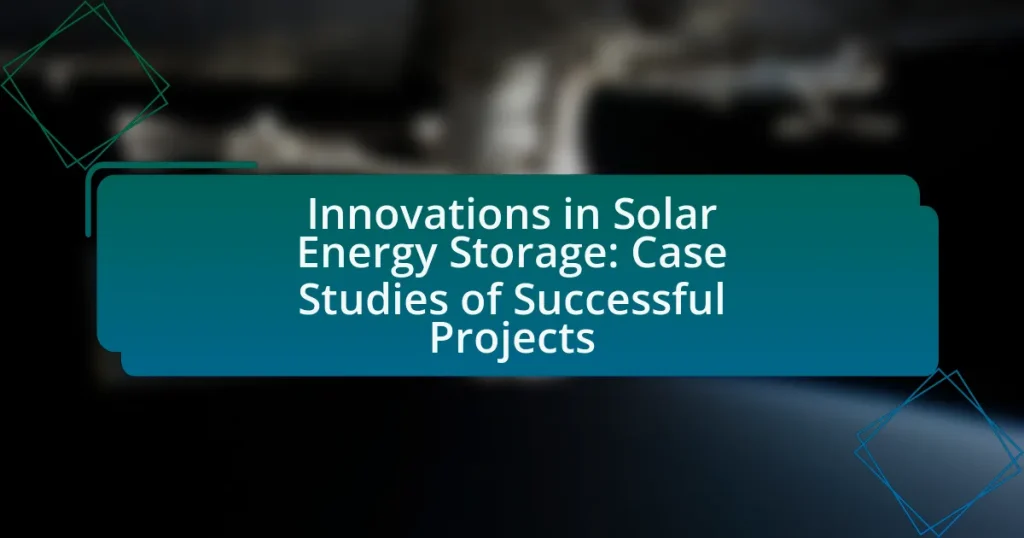Innovations in solar energy storage are transforming the renewable energy landscape, with advancements such as lithium-sulfur, flow, and solid-state batteries enhancing energy density, longevity, and safety. These technologies improve energy efficiency by enabling better management of solar energy supply and demand, facilitating the integration of renewable sources into the energy grid. Successful case studies, including the Hornsdale Power Reserve and Kauai Island Utility Cooperative, demonstrate the effectiveness of these innovations in promoting grid stability and reducing carbon emissions. The article explores the technologies driving these advancements, their impact on sustainability, and the lessons learned from successful projects, while also addressing future trends and practical steps for implementation.
What are Innovations in Solar Energy Storage?


Innovations in solar energy storage include advancements such as lithium-sulfur batteries, flow batteries, and solid-state batteries, which enhance energy density, longevity, and safety. Lithium-sulfur batteries, for instance, can achieve energy densities of up to 500 Wh/kg, significantly higher than traditional lithium-ion batteries, making them a promising option for large-scale energy storage. Flow batteries, which utilize liquid electrolytes, offer scalability and longer cycle life, with some systems exceeding 10,000 cycles. Solid-state batteries, currently in development, aim to replace liquid electrolytes with solid materials, potentially increasing safety and energy density while reducing fire risks. These innovations are crucial for improving the efficiency and reliability of solar energy systems, enabling better integration into the energy grid and supporting the transition to renewable energy sources.
How do these innovations impact energy efficiency?
Innovations in solar energy storage significantly enhance energy efficiency by enabling better management of energy supply and demand. These advancements, such as improved battery technologies and smart grid integration, allow for the storage of excess solar energy generated during peak sunlight hours for use during periods of low generation. For instance, lithium-ion batteries have shown to increase energy retention rates, with some systems achieving over 90% efficiency in energy conversion and storage. This capability reduces reliance on fossil fuels and minimizes energy waste, ultimately leading to a more sustainable energy ecosystem.
What technologies are driving these innovations?
The technologies driving innovations in solar energy storage include advanced battery systems, such as lithium-ion and flow batteries, as well as artificial intelligence for energy management. Lithium-ion batteries are widely used due to their high energy density and decreasing costs, which have made them a preferred choice for residential and commercial solar energy storage. Flow batteries, on the other hand, offer scalability and longer discharge times, making them suitable for larger energy storage applications. Additionally, artificial intelligence enhances energy management by optimizing the charging and discharging cycles based on consumption patterns and weather forecasts, thereby improving overall efficiency. These technologies collectively contribute to the effectiveness and reliability of solar energy storage solutions.
How do these technologies compare to traditional storage methods?
Innovative solar energy storage technologies, such as lithium-ion batteries and flow batteries, offer higher efficiency and faster charging times compared to traditional storage methods like pumped hydro storage. These modern technologies can achieve round-trip efficiencies of up to 90% or more, while traditional methods typically range from 70% to 80%. Additionally, solar energy storage solutions are more scalable and can be deployed in various settings, from residential to commercial, unlike traditional methods that often require specific geographical conditions. This adaptability is supported by the growing trend of decentralized energy systems, which enhances energy resilience and reduces transmission losses.
Why is solar energy storage important for sustainability?
Solar energy storage is crucial for sustainability because it enables the efficient use of solar power by storing excess energy generated during peak sunlight hours for use during periods of low sunlight or high demand. This capability enhances grid stability, reduces reliance on fossil fuels, and minimizes energy waste. According to the International Renewable Energy Agency, energy storage can increase the share of renewables in the energy mix, facilitating a transition to a more sustainable energy system.
What role does solar energy storage play in reducing carbon emissions?
Solar energy storage significantly reduces carbon emissions by enabling the use of renewable energy even when sunlight is not available. This technology allows excess solar energy generated during the day to be stored and used later, decreasing reliance on fossil fuels for electricity generation. According to the International Energy Agency, integrating energy storage with solar power can lead to a reduction of up to 70% in carbon emissions from the electricity sector by 2040. By facilitating a more stable and reliable energy supply, solar energy storage contributes to a cleaner energy grid and supports the transition to a low-carbon economy.
How does solar energy storage contribute to energy independence?
Solar energy storage significantly contributes to energy independence by allowing individuals and communities to store excess solar power for use during periods of low sunlight or high demand. This capability reduces reliance on external energy sources, such as fossil fuels or grid electricity, thereby enhancing self-sufficiency. For instance, a study by the National Renewable Energy Laboratory found that integrating solar storage systems can lead to a 30% reduction in energy costs and a substantial decrease in greenhouse gas emissions, further supporting the case for energy independence.
What are some successful case studies in solar energy storage?


Some successful case studies in solar energy storage include the Hornsdale Power Reserve in Australia, which utilizes Tesla’s Powerpack technology to provide grid stability and has a capacity of 150 MW/194 MWh. This facility has demonstrated the ability to respond to grid frequency events within milliseconds, significantly reducing the need for fossil fuel peaker plants. Another notable example is the Kauai Island Utility Cooperative in Hawaii, which integrated a solar-plus-storage system with a capacity of 28 MWh, allowing the island to achieve over 90% renewable energy generation during certain periods. These projects illustrate the effectiveness of solar energy storage in enhancing grid reliability and promoting renewable energy use.
How did these projects achieve their success?
These projects achieved their success through the implementation of advanced technologies and strategic partnerships. For instance, the integration of lithium-ion batteries in solar energy systems significantly improved energy storage efficiency, allowing for better management of energy supply and demand. Additionally, collaborations with research institutions and government agencies facilitated access to funding and resources, which accelerated project development and deployment. The combination of innovative technology and effective collaboration has been pivotal in driving the success of these solar energy storage projects.
What specific technologies were utilized in these case studies?
The specific technologies utilized in the case studies of solar energy storage innovations include lithium-ion batteries, flow batteries, and advanced thermal storage systems. Lithium-ion batteries are widely recognized for their high energy density and efficiency, making them suitable for residential and commercial solar energy storage. Flow batteries, which utilize liquid electrolytes, offer scalability and long-duration energy storage, ideal for balancing intermittent solar power. Advanced thermal storage systems, such as molten salt storage, enable the capture and retention of heat generated by solar energy, allowing for energy release during non-sunny periods. These technologies collectively enhance the reliability and efficiency of solar energy systems, as evidenced by their implementation in various successful projects.
What challenges did these projects face and how were they overcome?
The projects in solar energy storage faced challenges such as high initial costs, technological limitations, and regulatory hurdles. To overcome high initial costs, stakeholders secured funding through government grants and private investments, which facilitated the development of more affordable technologies. Technological limitations were addressed by investing in research and development, leading to advancements in battery efficiency and lifespan. Regulatory hurdles were navigated by engaging with policymakers to create supportive frameworks that encouraged innovation and streamlined approval processes for new technologies.
What lessons can be learned from these successful projects?
Successful projects in solar energy storage demonstrate the importance of integrating advanced technology with effective project management. These projects highlight that utilizing innovative battery technologies, such as lithium-ion and flow batteries, significantly enhances energy efficiency and storage capacity. For instance, the Hornsdale Power Reserve in Australia, which employs Tesla’s lithium-ion batteries, has proven to reduce energy costs and improve grid stability, showcasing the effectiveness of large-scale energy storage solutions. Additionally, collaboration among stakeholders, including government, private sector, and local communities, is crucial for securing funding and support, as seen in the success of the Solar Energy Storage Project in California. These lessons emphasize the need for technological innovation, strategic partnerships, and community engagement to achieve successful outcomes in solar energy storage initiatives.
How can these lessons be applied to future solar energy storage initiatives?
Lessons from successful solar energy storage projects can be applied to future initiatives by emphasizing the importance of integrating advanced battery technologies and optimizing system design for efficiency. For instance, projects that utilized lithium-ion batteries demonstrated significant improvements in energy density and cycle life, which can inform future designs to enhance performance and reduce costs. Additionally, the implementation of smart grid technologies in these case studies has shown that real-time data analytics can optimize energy distribution and storage, leading to more reliable systems. By adopting these proven strategies, future solar energy storage initiatives can achieve greater scalability and sustainability, ultimately contributing to the transition towards renewable energy sources.
What best practices emerged from these case studies?
Best practices that emerged from the case studies on innovations in solar energy storage include the integration of advanced battery technologies, effective energy management systems, and strategic partnerships. Advanced battery technologies, such as lithium-ion and flow batteries, have demonstrated improved efficiency and longevity, enhancing overall system performance. Effective energy management systems optimize energy usage and storage, ensuring that energy is available when needed, which is crucial for maximizing the benefits of solar energy. Strategic partnerships between technology providers, energy companies, and research institutions have facilitated knowledge sharing and resource allocation, leading to more successful project implementations. These practices have been validated through various successful projects that showcased increased energy reliability and reduced costs.
What are the future trends in solar energy storage innovations?


Future trends in solar energy storage innovations include advancements in battery technology, such as solid-state batteries and flow batteries, which offer higher energy densities and longer lifespans. Research indicates that solid-state batteries can potentially increase energy density by 50% compared to traditional lithium-ion batteries, enhancing efficiency in solar energy storage. Additionally, the integration of artificial intelligence and machine learning in energy management systems is expected to optimize storage usage and improve grid stability. According to a report by the International Energy Agency, the global energy storage market is projected to grow significantly, reaching 1,095 GWh by 2040, driven by these technological advancements.
How is research and development shaping the future of solar energy storage?
Research and development are significantly shaping the future of solar energy storage by advancing technologies that improve efficiency, capacity, and cost-effectiveness. Innovations such as solid-state batteries and flow batteries are being developed to enhance energy density and longevity, addressing the limitations of traditional lithium-ion batteries. For instance, a study published in the journal “Nature Energy” by researchers from Stanford University demonstrated that solid-state batteries could potentially increase energy density by 50% compared to current technologies. Additionally, R&D efforts are focusing on integrating artificial intelligence and machine learning to optimize energy management systems, which can lead to more efficient use of stored solar energy. These advancements are crucial for making solar energy a more reliable and sustainable power source, ultimately facilitating a transition to a low-carbon energy future.
What emerging technologies are on the horizon?
Emerging technologies on the horizon include advanced solar energy storage systems, such as solid-state batteries and flow batteries. These technologies are being developed to enhance energy efficiency and storage capacity, addressing the intermittent nature of solar power. For instance, solid-state batteries offer higher energy density and improved safety compared to traditional lithium-ion batteries, while flow batteries provide scalability and longer discharge times, making them suitable for large-scale solar applications. Research indicates that these innovations could significantly improve the viability of solar energy as a primary power source, with studies showing that solid-state batteries can achieve up to 300 Wh/kg energy density, compared to 150 Wh/kg for conventional batteries.
How might policy changes influence future innovations?
Policy changes can significantly influence future innovations by creating an environment that either fosters or hinders research and development. For instance, government incentives such as tax credits for renewable energy projects can stimulate investment in solar energy storage technologies, leading to advancements in efficiency and cost-effectiveness. A study by the International Renewable Energy Agency (IRENA) highlights that countries with supportive policies, like Germany and the United States, have seen accelerated growth in solar energy innovations, demonstrating a direct correlation between policy frameworks and technological progress.
What practical steps can be taken to implement solar energy storage solutions?
To implement solar energy storage solutions, one must first assess energy needs and select appropriate storage technology, such as lithium-ion batteries or flow batteries. Conducting a site evaluation to determine optimal solar panel placement and energy consumption patterns is essential. Next, integrating the storage system with existing solar infrastructure involves proper installation and configuration of inverters and charge controllers. Additionally, securing financing options, such as government incentives or grants, can facilitate the project. Finally, ongoing maintenance and monitoring of the system ensure efficiency and longevity. These steps are supported by the growing trend of solar-plus-storage projects, which have demonstrated increased energy resilience and cost savings in various case studies.
What considerations should be made when selecting a solar energy storage system?
When selecting a solar energy storage system, key considerations include capacity, efficiency, lifespan, and cost. Capacity determines how much energy can be stored and should align with energy consumption needs. Efficiency indicates how much of the stored energy can be used, impacting overall performance; for instance, lithium-ion batteries typically have an efficiency of around 90%. Lifespan is crucial as it affects long-term investment; many systems last between 10 to 20 years. Cost encompasses both initial investment and maintenance expenses, with average costs for residential systems ranging from $5,000 to $15,000. Evaluating these factors ensures the chosen system meets specific energy requirements and budget constraints effectively.
How can organizations effectively integrate solar energy storage into their operations?
Organizations can effectively integrate solar energy storage into their operations by implementing a combination of strategic planning, technology adoption, and financial analysis. Strategic planning involves assessing energy needs and determining the optimal size and type of storage system to complement existing solar installations. Technology adoption includes selecting advanced battery systems, such as lithium-ion or flow batteries, which enhance efficiency and reliability. Financial analysis is crucial for evaluating the return on investment, considering factors like energy savings, incentives, and potential revenue from grid services.
For instance, a study by the National Renewable Energy Laboratory found that organizations that paired solar energy with storage could reduce energy costs by up to 30% and improve energy resilience during outages. This evidence supports the effectiveness of integrating solar energy storage in operational frameworks.


